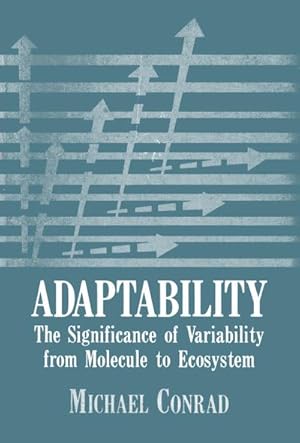adaptability significance variability molecule (1 Ergebnisse)
Produktart
- Alle Produktarten
- Bücher (1)
- Magazine & Zeitschriften
- Comics
- Noten
- Kunst, Grafik & Poster
- Fotografien
- Karten
-
Manuskripte &
Papierantiquitäten
Zustand
- Alle
- Neu
- Antiquarisch/Gebraucht
Einband
- alle Einbände
- Hardcover
- Softcover
Weitere Eigenschaften
- Erstausgabe
- Signiert
- Schutzumschlag
- Angebotsfoto
Land des Verkäufers
Verkäuferbewertung
-
Adaptability : The Significance of Variability from Molecule to Ecosystem
Verlag: Springer US, 2012
ISBN 10: 1461583292ISBN 13: 9781461583295
Anbieter: AHA-BUCH GmbH, Einbeck, Deutschland
Buch
Taschenbuch. Zustand: Neu. Druck auf Anfrage Neuware - Printed after ordering - Inhaltsangabe1. The Ecosystem Process.- 1.1. Pond Water in a Flask.- 1.2. The Uncertain Ecosystem.- 1.3. Balance.- 1.4. The Theory of Evolution.- 2. The Laws of Dissipation.- 2.1. Energy and Entropy Transformations in Open Systems.- 2.2. The Importance of Dissipation.- 2.3. Statistical Significance of Dissipation.- 2.4. Breaking the Conservation Law.- 2.5. Further Remarks on the Origin of Irreversibility.- 2.6. Forgetting Perturbation.- 2.7. Ignoring Perturbation.- 2.8. Reducing Perturbation and the Significance of Quantum Variability.- References.- 3. The Dissipative Ecosystem.- 3.1. Selective Dissipation and Self-Reproduction.- 3.2. Self-Assembly and Self-Reorganization.- 3.3. Dissipative Patterns and Dissipative Repatterning.- 3.4. Patterns of Activity.- 3.5. Information Unbound.- 3.6. Information and Organization.- 3.7. The Chessboard Analogy.- 3.8. The Forgetful Ecosystem.- References.- 4. Statistical Aspect of Biological Organization.- 4.1. Behavioral Description.- 4.2. Statistical Measures.- 4.3. Fundamental Identity.- 4.4. Fundamental Inequality.- 4.5. Regular Capacity.- 4.6. Time Scales and Information Flow.- 4.7. Information Transfer Picture.- 4.8. Further Remarks on Information Transfer.- 4.9. Two-Time Formalism.- 4.10. Diversity of Behavior.- 4.11. The Variability of Biological Matter.- Addendum: Structural Correspondence between Transition Scheme and Two-Time Formalism.- References.- 5. Hierarchical Aspect of Biological Organization.- 5.1. Compartmental Structure of the Ecosystem.- 5.2. States of Compartments.- 5.3. Reference Structures.- 5.4. Transition Schemes Again.- 5.5. The Canonical Representation.- 5.6. Statistical Laws.- 5.7. Interpretation of the Terms.- 5.8. Further Biological Correlates.- References.- 6. Evolutionary Tendency of Adaptability.- 6.1. The Basic Argument.- 6.2. General Mechanisms.- 6.3. Correlation and Decorrelation Mechanisms.- 6.4. Apparent Paradox of Competition.- 6.5. Mechanisms and Modes of Adaptability.- 6.6. Dispensing with Adaptability.- 6.7. Physiological Tendencies.- 6.8. Upper Bound of Adaptability.- 6.9. Self-Consistency of Hierarchical Adaptability Theory.- 6.10. Segregation of Genotype and Phenotype.- 6.11. Operational Definition of Adaptability.- References.- 7. The Meaning of Efficiency.- 7.1. The Connection between Efficiency and Fitness.- 7.2. Thermodynamic Parameters of Efficiency.- 7.3. Fitness and Efficiency in the Light of Thermodynamics.- 7.4. Reformulating Statements about Efficiency.- 7.5. Biomass and Turnover in the Context of Efficiency.- 7.6. Evolution of Efficiency.- References.- 8. The Connection between Adaptability and Dynamics.- 8.1. Autonomy, Predictability, and the Bath of Unrepresented Adaptabilities.- 8.2. Biology of Stability, Instability, and Bifurcation.- 8.3. Interpretation of a Classical Model and Significance of Chaos.- 8.4. H( ) versus .- References.- 9. The Connection between Adaptability and Reliability.- 9.1. Embedded Communication Network and the In-Principle Solution.- 9.2. Essentials of the Proof.- 9.3. More General Situations and Qualifying Comments.- 9.4. Biochemical Proofreading.- 9.5. Interdependence of Reliability and Adaptability.- References.- 10. Adaptability Theory Analysis of the Genotype-Phenotype Relationship.- 10.1. The Mutation-Absorption Paradigm.- 10.2. Formalization of the Mutation-Absorption Model.- 10.3. The Bootstrap Principle of Evolutionary Adaptability.- 10.4. Issue of Neutralism and Significance of the Magnitudes.- 10.5. Adaptability of the Adaptive Landscape.- 10.6. Extension to Multigene Systems.- 10.7. Bootstrapping of the Cyclic Nucleotide System.- 10.8. The Buffer Structure Principle of Phenotypic Organization.- 10.9. Bootstrapping Is Possible Only in Nondecomposable Systems.- 10.10. Relation to Other Discussions of Evolution and Development.- References.- 11. Compensation in Organisms and Populations.- 11.1. Homeostasis.- 11.2. The Niche and Its Role in Compensation.- 11.3. Factors Affecting the Allocation of the Entropie.


